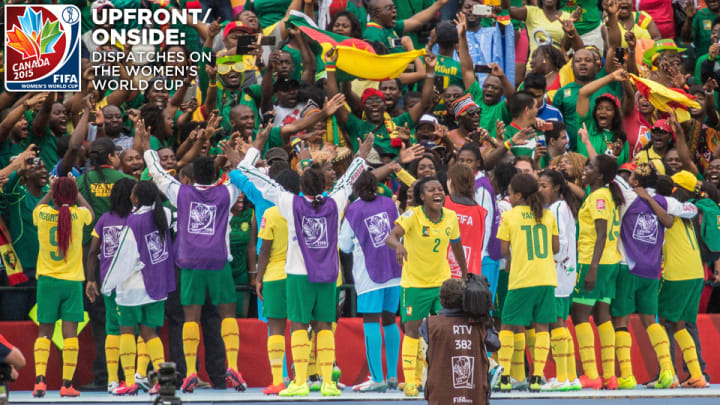Beware les Lionnes: Cameroon surprises in Women's World Cup

It was one of the most intriguing–and pleasantly surprising–matchups of the Women's World Cup so far: Switzerland vs. Cameroon.
Switzerland was playing in the World Cup for the first time, having long struggled to qualify in competition with many strong European teams. During the past year, however, the Swiss shone during qualifying, and are currently ranked 19th by FIFA. They benefit from comparatively good support from the well-funded Swiss Football Federation, though, as everywhere else, they receive far less funding than the men’s program. The team includes the star player Lara Dickenmann, who has had a successful college and professional career in the U.S.
Cameroon, meanwhile, was also in its first World Cup, one of three African sides in the tournament along with the Ivory Coast and Nigeria. Few, however, predicted that Cameroon, ranked 53rd in the world by FIFA, would light up the pitch and earn so many admirers, becoming the only African team to progress to the knockout stage. Along with Costa Rica and Colombia, this team has become one of the great discoveries in the last few weeks, and a good example of why expanding the field to 24 teams has been a good thing for both particular teams and women’s soccer as a whole.
The star of the Cameroonian team is Gaëlle Enganamouit, who plays professionally in Sweden’s excellent professional league, for Eskilstuna United DFF. She previously played in Serbia, where she made history scoring the fastest goal in the history of women’s soccer, a bold strike from midfield.
In a pre-tournament portrait, she sports a blond mane and has her claws out, an evocation of the team’s nickname, les Lionnes, or Lionnesses. She was a force during Cameroon’s opening 6-0 victory against a beleaguered Ecuador team, scoring a hat trick.
[youtube:https://youtu.be/VitJqREr-Aw]
But the team is full of talented players including midfielder Raissa Feudjio, who plays professionally in Finland, as well as Yvonne Leuko Chibosso and Madeleine Ngono (scorer of the winning goal against Switzerland), who both play professionally in France.
Amid Women's World Cup run, France fights for media spotlight at home
Though Cameroon fell to reigning champion Japan 2-1 in a hard-fought second match, Cameroon played a technically brilliant and relentless game against Switzerland in its third game, winning 2-1 and securing a spot in the last 16 against China. If Cameroon wins that match, it will face either the United States or Colombia in an improbable quarterfinal. The team has already made history for its country by solely appearing in the tournament.
By making it out of the group stage it has already done better than Nigeria, (considered one of the leading women’s teams on the continent), which has never succeeded in doing so and once again faltered this time.
So what explains Cameroon’s success, especially in comparison to the depressing performance by Ivory Coast, which stared its run with a 10-0 loss to Germany?
It is certainly not thanks to Cameroon’s federation, which is notoriously corrupt and disorganized. FIFA suspended the Cameroonian FA in 2013 because of interference by the country’s dictator Paul Biya in its elections–and when FIFA thinks an organization is too corrupt to be accepted, that is saying something.
Despite steps forward, Mexico still seeks support at Women's World Cup
The ongoing problems in the federation have contributed to poor showings in recent men's World Cups, despite an impressive reservoir of talent that includes Benoît Assou-Ekotto and Samuel Eto’o, the latter of whom has been in regular open conflict with the federation. This has been particular depressing for those who remember the great Cameroonian teams of years past, who made it to the World Cup quarterfinals in 1990 led by the luminous Roger Milla.
Women’s football in Cameroon has been in crisis during the past year. As with the men’s team, there have been conflicts between the women’s team and the federation over promised bonuses for World Cup qualification. Eight of the 14 women’s professional teams in the country were suspended after they refused to play in protest for not receiving the (quite small) subventions they were due. The inequalities and struggles faced by women’s players in Cameroon parallel those of national teams in many other countries. But given the particularly difficult context of football in the country, their success at the World Cup is all the more remarkable, and indeed inspiring.
Cameroon has a deep footballing history going back to the early 20th century, and many of the team’s female players describe finding a nurturing space to play in their communities as they were growing up, often incorporated into local boys teams. That, rather than any real institutional support, seems to be one of the sources of their joyous, ranging style of attack.
Cameroon has also profited from the fact that key players have found a way to professional careers in European professional leagues in France and Scandinavia. But they, and the next generation of Cameroonian players, would clearly profit from a more stable women’s league in their country, where they can play at home and grow the sport.
Their faceoff against China Saturday night in Edmonton will be a challenge, but the Lionnes have already shown that, as far as they are concerned, anything is possible.
Laurent Dubois is the author of Soccer Empire: The World Cup and the Future of France (2010), and edits the Soccer Politics blog. His writing has appeared on SI.com as part of the 2014 Roads and Kingdoms series “The Far Post.” He teaches at Duke University and can be followed on Twitter @Soccerpolitics.
